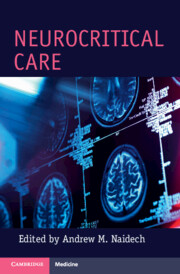Book contents
- Neurocritical Care
- Neurocritical Care
- Copyright page
- Contents
- Contributors
- 1 Introduction
- 2 Intracranial Pressure Monitoring and Management
- 3 Disorders of Temperature Regulation
- 4 Approach to Neuroimaging of the Brain, Vessels, and Cerebral Edema
- 5 Airway and Ventilator Management of the Neurologically Critically Ill Patient
- 6 Neurocritical Care Pharmacology
- 7 Intracerebral Hemorrhage
- 8 Correction of Coagulopathy
- 9 Subarachnoid Hemorrhage
- 10 Subdural Hematoma
- 11 Critical Care Management of Neurotrauma
- 12 Critical Care Management before and after Open and Intravascular Procedures
- 13 Shared Decision-Making in the Neuro-ICU
- 14 Status Epilepticus and EEG Monitoring
- 15 Evaluation of the Comatose Patient and Overview of the Brain Death Examination
- Index
- References
3 - Disorders of Temperature Regulation
Published online by Cambridge University Press: 19 May 2022
- Neurocritical Care
- Neurocritical Care
- Copyright page
- Contents
- Contributors
- 1 Introduction
- 2 Intracranial Pressure Monitoring and Management
- 3 Disorders of Temperature Regulation
- 4 Approach to Neuroimaging of the Brain, Vessels, and Cerebral Edema
- 5 Airway and Ventilator Management of the Neurologically Critically Ill Patient
- 6 Neurocritical Care Pharmacology
- 7 Intracerebral Hemorrhage
- 8 Correction of Coagulopathy
- 9 Subarachnoid Hemorrhage
- 10 Subdural Hematoma
- 11 Critical Care Management of Neurotrauma
- 12 Critical Care Management before and after Open and Intravascular Procedures
- 13 Shared Decision-Making in the Neuro-ICU
- 14 Status Epilepticus and EEG Monitoring
- 15 Evaluation of the Comatose Patient and Overview of the Brain Death Examination
- Index
- References
Summary
As the first vital sign, temperature occupies a prominent place in the initial assessment of a patient and is of particular significance in an acutely ill patient in the neurocritical care unit. Its interpretation, measurement, and clinical significance can be confounded by the disruption of the normal thermoregulatory mechanisms of the central nervous system, as well as various pharmacotherapies. This chapter aims to provide the reader with an overview of the clinical approach to fever in the neurocritical care unit. This will encompass a discussion of the common causes of fever, including serotonin syndrome, neuroleptic malignant syndrome, malignant hyperthermia, and paroxysmal sympathetic hyperreactivity. Finally, we describe how temperature can be leveraged as an evidence-based therapeutic tool to help improve neurologic outcomes after cardiac arrest.
- Type
- Chapter
- Information
- Neurocritical Care , pp. 32 - 64Publisher: Cambridge University PressPrint publication year: 2022



